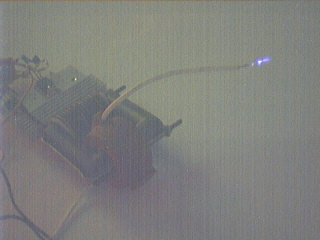
|
Author's experiments |
|
|
Alternative coronas
Contents
1 - General properties
2 - Low
frequencies versus high frequencies
3 - Observations
4 - Interpretation
5 - Neutral wind
evidence
6 - Conclusion
A very usual example of alternative coronas is the coronas produced by the high voltage power lines (The humming noise is due to the hydrodynamic effects of the coronas). The electrical aspect of the corona depends strongly on the frequency. If the frequency is low i.e. if the period is long compared to the transit time of the ions between the electrodes, the discharge is well established during the alternation and looks like the continuous one. If the frequency is high enough, the ions may not reach the collector before the opposite ions are emitted so they are recombination in the bulk of the fluid and the aspect and the properties of the discharge are strongly modified.
2 - Low frequencies versus high frequencies
We can then consider two very different regimes. The low frequency regime will correspond to the case where all the charges are able to reach the collector before the opposite polarity charges are emitted. In the high frequency regime by opposition, all the charges will recombine in the gap and no other electrode than the emitter needs to be present.
In the low frequency regime there is usually only an oscillation between the positive and negative corona. The hydrodynamic effect, which is always a repulsion from the strained electrode, is then nearly the same that the one obtained in a continuous corona. The wind is, using an electric comparison, rectified. Only subsist a small modulation at twice the electric frequency (the inertia of the neutrals although very low has a filtering effect). The global result is a sort of average between positive and negative corona. However they are some differences that could lead in particular situations to quite different behaviours compared to the continuous ones.
If some insulator walls are in (or not too far from) the electrical flow region, they will not be submitted to long term charge deposit action. The charge deposit on wall is a real problem because it can lead to a total extinction of the glow. If the glow is maintained, through a higher voltage, local breakdowns will appear on the insulator surface from point to point in order to remove the excess of charges. These noisy random sparkling are for instance a great problem as far as acoustic sources are involved. In alternative regime long term deposit are removed and the discharge is more stable and silent.
The other important consequence is that it is possible in alternative current to put a condenser in series in the circuit. In this case if breakdown occurs, the maximum energy that can be obtained in the gap is the energy stocked in the condenser. The simple use of a single condenser can then have a drastic effect for stability. It is for instance possible to get closer to the breakdown without any risk, even if breakdown occurs for some alternation. The explanation is simple, if the energy given to the fluid is small enough in order that the thermal effects remain small, the breakdown may not occur in the following alternations. Then, not only the destroying effect of hazardous sparking is avoided, but it is possible to work closer to the breaking point then to get higher performances.
In the following we will spent more time to see what happens when the frequency is high enough for all the charges to recombine before they can reach any other electrode.
The following experiment was made with the simple materiel described in the Corona Lab page. In the following observations the resonance frequency of the secondary is : 108 kHz.

The whole apparatus (power supply is not shown)
The corona emitter is constituted of a simple cut electric wire (wire diameter around 0.1 mm). The small wire is directly soldered to a high voltage transformer.
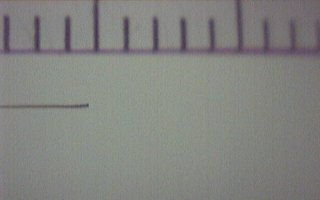
Close-up and scale
When the alternative voltage is increased progressively from zero, a small glow appears suddenly and is maintained even if the voltage is slightly decreased (hysteresis effect).
The glow at the threshold level (click to enlarge)
The glow at the threshold is relatively instable, it may oscillate from one side to an other or even rotate around the tip (see instabilities for more details). When the voltage is increased again the brightness increases and the glow becomes more stable and covers all the wire's tip.
The normal glow regime (click to enlarge)
If the voltage continue to rise the glow start to climb along the wire but the aspect on the tip do not change too much. When saturation is reached all along the wire, the size of the glow rises rapidly but the situation remains stable and reversible.
The rapid extension in the stable regime (click to enlarge)
When the glow extension reaches a maximum value of around 1mm, some type of breakdown occurs. There is no intermediate regime, the glow size is either 1 mm or around 8 mm. Moreover the situation is really instable (see the video below) and seems to be constituted of numerous small filaments with a visible spreading in angles (around +/-10 degrees) and length (+/- 1mm).
The breakdown regime (click to enlarge)
Video of the point-to-nothing discharge
(the voltage is increased progressively until breakdown occurs)
Click
to enlarge(700 kB)
This is probably the most promising aspect of the corona and the most unknown. I made experiments on frequencies up to 300 kHz but probably the corona exists for frequencies up to several MHz. It is clear that if the distance covered by the ions during one period is below the average free path, the induced movement on the neutrals will be small compared with the thermal effects. This should only happen for frequencies on the order of 100 MHz. For frequencies lower than that, the hydrodynamics effects even if localized very close to the emitter will still be important.
One practical and very interesting result is that for frequencies higher than 100 kHz the distance covered by the ions during an alternation is only a few millimetres. In usual configurations, the ions will then recombine before reaching the collector. The collector is then not necessary. Everything looks like there is a virtual collector at some distance from the emitter. The distance where recombination occurs is of course closely related to frequency.
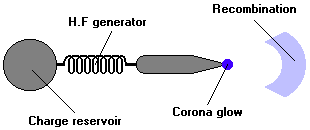
Moreover if the voltage is raised above a certain value a sparking appears between the strained electrode and the relaxation area, i.e. between the strained electrode and....nothing! I was able to obtain quasi-stable filaments of around 1 cm long.

5 - Evidence of the electric wind presence
The following experiments were made with a very light sphere of polystyrene attached with a very thin cotton wire. The only stable position for the pendulum in the absence of discharge is vertical.
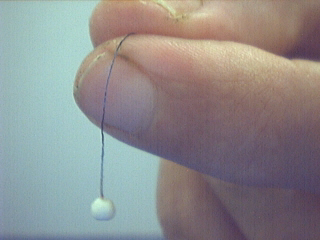
The small polystyrene sphere and the cotton wire
In order to set clearly in evidence the electric wind and its stabilizing effect the emissive point was set vertically.
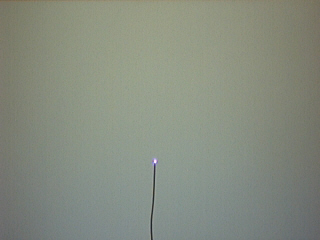
The vertical point to nothing discharge
When the sphere is approached to the discharge area, a clear repulsion is seen.
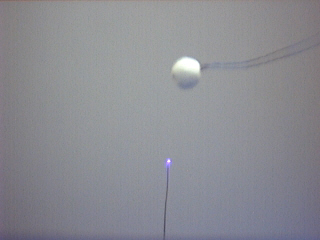
Vertical repulsion of the sphere
The repulsion could not be caused by electrostatic repulsion because we are in a high frequency discharge. Moreover a faint blowing is perceptible at bare hand (a cold sensation on the skin).
For a current high enough the sphere is expulsed vertically by the neutral wind influence.
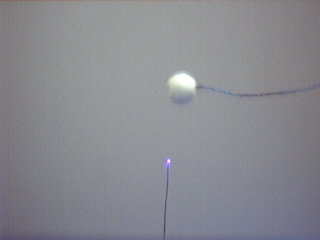
Vertical expulsion of
the sphere
(click here for the video 1.2 MB)
Moreover it is possible to verify that this situation is stable (in the same manner than a balloon in a vertical water jet). This is another application of the Bernoulli theorem. The pressure decreases when the velocity increase then the static pressure is always lower in the centre of the jet than on the sides. A force always directed to the centre of the jet will apply on any object situated not too far from the axis. This force will bring the object to a central position a soon as oscillations are dumped by the dissipative effect of viscosity forces.
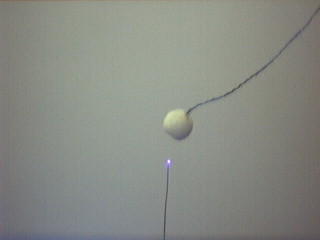
Hydrodynamic stability evidence
(click here for the video 1.2MB)
High frequency coronas are a potential solution to solve the problem of interactions with walls (see the boundary layer page for more details on the interaction problems). H.F coronas can be used in the case of downstream propulsion leading to very small hydrodynamic losses or for acoustic generation (see practical realizations) because they are totally silent. And, last but not least, they are cheaper to produce (you don't need H.V rectifiers) easier to manage (no risks of uncontrolled sparking) and totally secure (the energy developed in each alternation is very small).